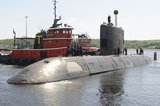SAS 2016: LCS gets Harpoon missile
‘If it floats, it needs to fight’, Capt Jaime Engdahl, programme manager for Precision Strike Weapons and the LRASM Deployment Office told the Sea-Air-Space exhibition in Washington DC.
‘It needs to be able to take on over-the-horizon anti-ship [missions],’ Engdahl said during an update on the US Navy’s precision strike weapons portfolio, describing an accelerated effort that began in January of this year to provide installation and integration of the Harpoon missile aboard the Littoral Combat Ship USS Coronado (LCS-4).
‘Right now they are finishing up the installs and, when they deploy, we will have over the horizon targeting capability
Already have an account? Log in
Want to keep reading this article?
More from Naval Warfare
-
![US Navy to conduct an experimentation campaign with emerging tech in 2026 and 2027]()
US Navy to conduct an experimentation campaign with emerging tech in 2026 and 2027
The Technology Operational Experimentation Events will inform future requirements as the US Navy looks for innovative solutions across three key operational domains.
-
![Future Canadian Continental Defence Corvette will provide “Halifax-equivalent capabilities”]()
Future Canadian Continental Defence Corvette will provide “Halifax-equivalent capabilities”
Although the CDC project is still in its early stages, the Canadian Department of National Defence already has some requirements for the future platforms.
-
![US Navy to acquire micro-uncrewed underwater vehicles for ISR and coastal data collection]()
US Navy to acquire micro-uncrewed underwater vehicles for ISR and coastal data collection
The Naval Supply Systems Command is seeking authorised resellers of JaiaBot uncrewed underwater vehicles and multivehicle pods. The platforms will support undergraduate education at the US Naval Academy.





















